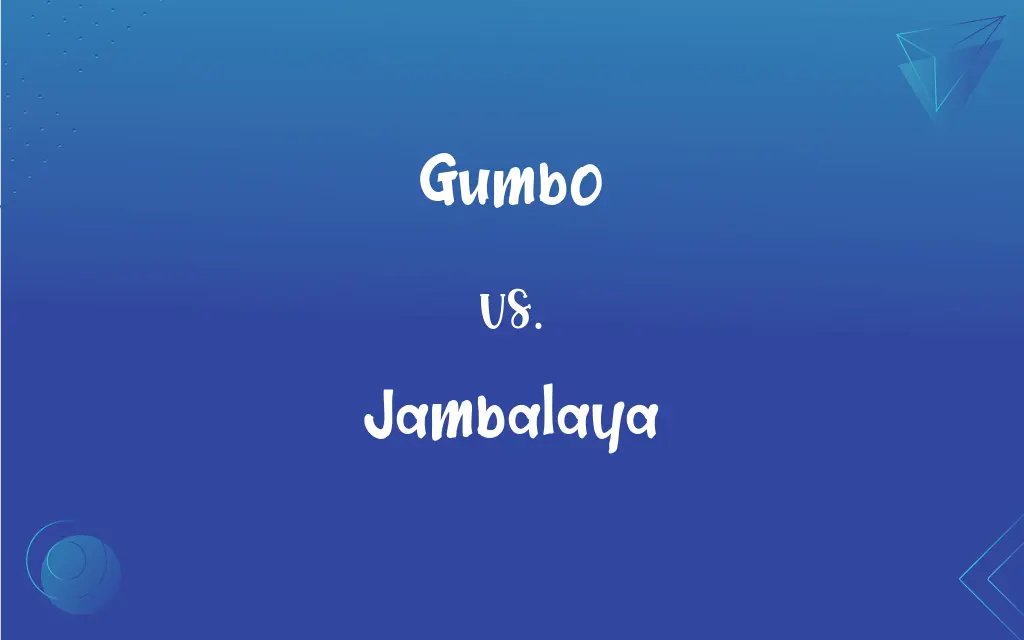Gumbo vs. Jambalaya: What's the Difference?
Edited by Aimie Carlson || By Janet White || Published on March 4, 2024
Gumbo is a stew-like dish with a roux base, while jambalaya is a rice-based dish, both rich in flavor and rooted in Louisiana cuisine.

Key Differences
Gumbo and jambalaya are both staple dishes in Louisiana cuisine, deeply rooted in cultural traditions. Gumbo, a thick stew, often features a variety of meats or seafood, vegetables, and the essential ingredient, okra, which acts as a thickener. Jambalaya, on the other hand, is a rice-based dish, akin to a hearty casserole, combining meat or seafood, rice, and often a blend of vegetables, cooked in a single pot. The distinction in consistency is notable: gumbo is served over rice, emphasizing its soup-like texture, while in jambalaya, the rice absorbs the flavors of the other ingredients, creating a robust, all-encompassing dish.
The base of gumbo and jambalaya provides a clear distinction between the two. Gumbo starts with a roux, a cooked mixture of flour and fat, which gives it a distinctive depth and serves as a thickening agent. Jambalaya skips the roux, relying on the natural starches of the rice and the cooking process to achieve its desired consistency. This fundamental difference in preparation highlights the stew-like quality of gumbo versus the denser, rice-focused nature of jambalaya. While gumbo can be either Creole or Cajun, with Creole versions incorporating tomatoes and Cajun versions focusing on a darker roux, jambalaya also comes in Creole and Cajun styles, with the former known as "red jambalaya" due to the use of tomatoes, and the latter omitting them for a smokier flavor.
The cultural origins of gumbo and jambalaya reflect the melting pot of Louisiana's history. Gumbo, with its West African roots, is a testament to the influence of enslaved Africans, who introduced okra to the dish. Jambalaya, meanwhile, shows Spanish and French influences, reminiscent of paella in its use of rice and mixed proteins. Both dishes exemplify the fusion of cultural influences in Louisiana cuisine, but gumbo's use of okra and a roux base leans more heavily on African culinary traditions, while jambalaya's rice-centric preparation echoes European influences.
Ingredient flexibility is a common trait between gumbo and jambalaya, allowing for a wide range of proteins to be used, from chicken and sausage to various seafood. However, gumbo often incorporates a broader variety of vegetables, such as bell peppers, celery, and onions (known as the "holy trinity" of Cajun cuisine), along with okra. Jambalaya, while also using the "holy trinity," typically focuses more on the interplay between the rice and meats, with less emphasis on additional vegetables. This difference highlights gumbo's role as a vegetable-rich stew compared to jambalaya's meat and rice-centric composition.
Serving traditions for gumbo and jambalaya also differ, reflecting their distinct characteristics. Gumbo is traditionally served as a main dish with rice served separately, allowing diners to adjust the rice-to-stew ratio to their liking. Jambalaya, being a complete dish with rice, meat, and vegetables, is served as is, offering a comprehensive flavor experience in every bite. Despite these differences, both gumbo and jambalaya remain beloved dishes, celebrated for their rich flavors and cultural significance in Louisiana cuisine.
ADVERTISEMENT
Comparison Chart
Base
Roux (flour and fat), okra, or filé powder
Rice
Consistency
Soup-like, served over rice
Casserole-like, with rice cooked in
Typical Ingredients
Seafood, chicken, sausage, "Holy Trinity"
Seafood, chicken, sausage, "Holy Trinity"
Cultural Influences
African, French, Spanish
Spanish, French
Varieties
Creole (with tomatoes), Cajun (without)
Creole (with tomatoes), Cajun (without)
ADVERTISEMENT
Gumbo and Jambalaya Definitions
Gumbo
Often thickened with roux, okra, or filé powder.
The key to a good gumbo is the dark roux.
Jambalaya
A Creole and Cajun dish that combines rice with meats and vegetables.
Our jambalaya tonight features chicken, shrimp, and andouille.
Gumbo
Served over rice, enhancing its flavors and textures.
Serve the gumbo hot over a bed of fluffy white rice.
Jambalaya
Absorbs flavors from its ingredients, creating a savory dish.
The rice in the jambalaya soaked up all the wonderful spices.
Gumbo
Can vary from Creole to Cajun, showcasing regional tastes.
We prefer a Cajun gumbo, spicy and without tomatoes.
Jambalaya
Can be Creole (red) with tomatoes or Cajun (brown) without.
I've made a Creole jambalaya, rich with tomatoes and spices.
Gumbo
A melting pot of cultural influences in a bowl.
Gumbo embodies the rich history of Louisiana.
Jambalaya
Reflects the fusion of cultures in Louisiana cuisine.
Jambalaya is a testament to Louisiana's cultural melting pot.
Gumbo
A Louisiana stew known for its complexity and variety.
Tonight's gumbo is full of shrimp and andouille sausage.
Jambalaya
Known for its one-pot preparation, making it a hearty meal.
Jambalaya is perfect for feeding a large crowd.
Gumbo
Chiefly Southern US See okra.
Jambalaya
A Creole dish consisting of rice that has been cooked with shrimp, oysters, ham, or chicken and seasoned with spices and herbs.
Gumbo
A soup or stew thickened with okra pods. Also called okra.
Jambalaya
Any of various of rice-based dishes common in Louisiana Cajun or Creole cooking; most often with shrimp, oysters, chicken or ham.
Jambalaya
A spicy Creole dish of rice with ham, sausage, chicken, or shellfish, plus tomatoes, and seasoned with peppers, onions, herbs, and celery.
Jambalaya
Spicy Creole dish of rice and ham, sausage, chicken, or shellfish with tomatoes, peppers, onions, and celery
FAQs
What is jambalaya?
Jambalaya is a Louisiana dish of Spanish and French influence, consisting of rice cooked with chicken, sausage, seafood, and vegetables, often including the "Holy Trinity."
What's the "Holy Trinity" in Louisiana cooking?
The "Holy Trinity" refers to the combination of diced onions, bell peppers, and celery, fundamental to many Louisiana dishes, including gumbo and jambalaya.
What's the main difference between gumbo and jambalaya?
The main difference is that gumbo is a soup or stew served over rice, while jambalaya is a rice-based dish where the rice is cooked with all the other ingredients.
Can jambalaya be vegetarian?
Yes, jambalaya can be adapted to be vegetarian by omitting traditional meats and using vegetable stock and an assortment of vegetables.
How spicy is jambalaya?
The spice level of jambalaya can vary widely depending on the recipe and personal preference. It can range from mild to very spicy.
What thickens gumbo?
Gumbo can be thickened with a roux (a mixture of flour and fat), okra, or filé powder (ground sassafras leaves).
Can I use any type of rice for jambalaya?
Long-grain white rice is traditionally used for jambalaya, as it holds up well during cooking and absorbs flavors nicely.
What is gumbo?
Gumbo is a stew originating from Louisiana, often thickened with roux, okra, or filé powder and containing a mix of meat and/or seafood, along with the "Holy Trinity" of onions, bell peppers, and celery.
Is gumbo always made with seafood?
No, gumbo can be made with a variety of proteins, including chicken, sausage, and seafood, or even vegetarian options.
What is the best way to serve jambalaya?
Jambalaya is best served hot, directly from the pot it was cooked in, often garnished with green onions or parsley.
Does jambalaya contain tomatoes?
Creole jambalaya, often referred to as "red" jambalaya, includes tomatoes, whereas Cajun jambalaya does not.
What meats are commonly used in jambalaya?
Common meats include chicken, andouille sausage, and sometimes seafood like shrimp or crawfish.
Can gumbo be made ahead of time?
Yes, gumbo often tastes better the next day as the flavors have more time to meld, making it an excellent make-ahead dish.
Is it necessary to use andouille sausage in jambalaya?
While andouille sausage is traditional and adds a distinct flavor, other smoked sausages can be substituted if andouille is not available.
Is rice always included in jambalaya?
Yes, rice is a key component of jambalaya, cooked with the other ingredients to absorb the rich flavors.
Is gumbo served as a main dish?
Yes, gumbo is hearty enough to serve as a main dish, especially when accompanied by rice and possibly side dishes like cornbread.
What is the origin of gumbo?
Gumbo has diverse influences, including West African, French, Spanish, and Native American, reflecting the cultural melting pot of Louisiana.
Is filé powder essential for gumbo?
While not essential, filé powder is a traditional gumbo ingredient, adding a distinctive flavor and aiding in thickening.
How do you know when gumbo is done?
Gumbo is done when the flavors have melded together, the meats are tender, and the stew has reached the desired consistency.
Can I freeze leftover gumbo?
Yes, gumbo freezes well. Cool it completely, then store it in an airtight container. It can be reheated on the stove or in a microwave.
About Author
Written by
Janet WhiteJanet White has been an esteemed writer and blogger for Difference Wiki. Holding a Master's degree in Science and Medical Journalism from the prestigious Boston University, she has consistently demonstrated her expertise and passion for her field. When she's not immersed in her work, Janet relishes her time exercising, delving into a good book, and cherishing moments with friends and family.
Edited by
Aimie CarlsonAimie Carlson, holding a master's degree in English literature, is a fervent English language enthusiast. She lends her writing talents to Difference Wiki, a prominent website that specializes in comparisons, offering readers insightful analyses that both captivate and inform.
































































